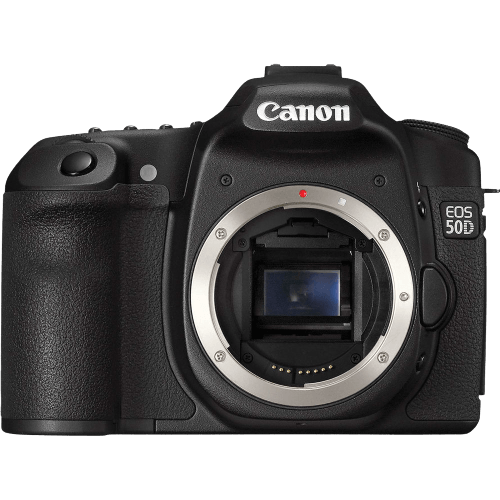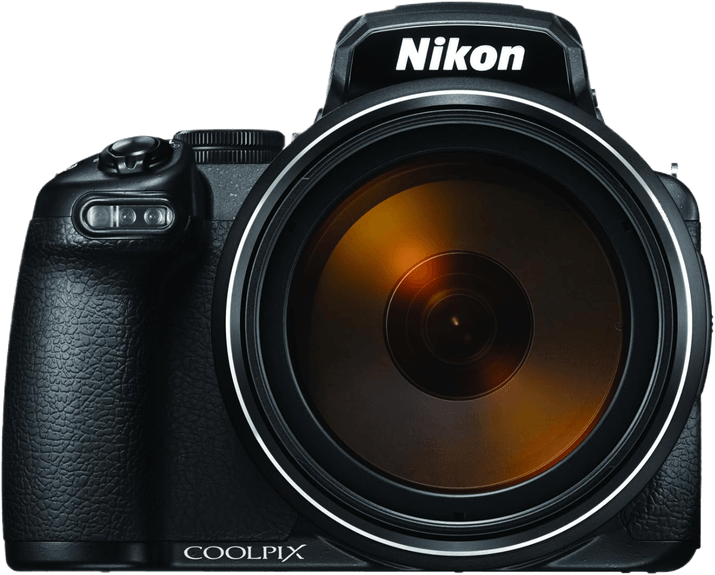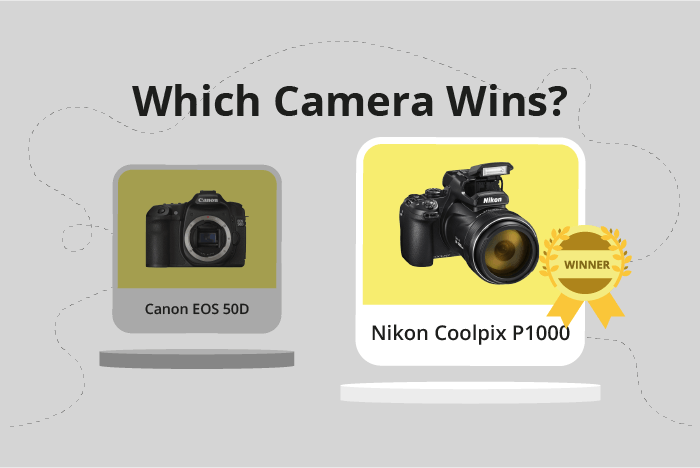Canon EOS 50D vs Nikon Coolpix P1000 Comparison
Canon EOS 50D

Nikon Coolpix P1000

The Nikon Coolpix P1000 comes out on top with a score of 52/100, compared to the Canon EOS 50D’s 48/100. Both cameras share similarities such as their announcement dates in 2008 and 2018, respectively, and their camera sizes (146 x 108 x 74mm for Canon and 146 x 119 x 181mm for Nikon).
The Nikon P1000 is superior due to its lower launch price of $999.95 and higher overall score. However, the Canon EOS 50D is lighter, weighing 822g (1.81lbs) compared to the Nikon’s 1415g (3.12lbs).
Considering these factors, the Nikon Coolpix P1000 is the better choice for its lower price and higher score, while the Canon EOS 50D may be preferable for those seeking a lighter camera.
Canon EOS 50D vs Nikon Coolpix P1000 Overview and Optics
The Nikon Coolpix P1000 outperforms the Canon EOS 50D in optics, scoring 53/100 compared to the Canon’s 47/100. Both cameras share some common specifications, such as having a CMOS sensor and similar megapixel counts (16 for the Nikon and 15.1 for the Canon). Additionally, both cameras have different aspect ratios: 4:3 for the Nikon and 3:2 for the Canon.
The Nikon Coolpix P1000 has several advantages over the Canon EOS 50D. Its higher shooting speed of 7 frames per second allows for better capture of fast-moving subjects. The Nikon’s Expeed processor and DXOMARK sensor score of 69 contribute to superior image quality. Moreover, the P1000 features image stabilization, which helps reduce camera shake and results in sharper images.
On the other hand, the Canon EOS 50D has a larger sensor size (APS-C) compared to the Nikon’s 1/2.3″ sensor. This difference can potentially lead to better low-light performance and increased dynamic range. The Canon also has a lens mount (Canon EF-S) that allows for a variety of lenses, offering greater flexibility for photographers.
Despite its advantages, the Canon EOS 50D falls short in the optics department compared to the Nikon Coolpix P1000. The Nikon’s higher score is attributed to features such as image stabilization, faster shooting speed, and a superior processor. Meanwhile, the Canon’s larger sensor size and lens mount offer some benefits but are not enough to surpass the Nikon in overall optical performance.
Canon EOS 50D vs Nikon Coolpix P1000 Video Performance
When it comes to video capabilities, the Canon EOS 50D does not offer any video functionality. Therefore, this comparison will focus solely on the Nikon Coolpix P1000 and its video features.
The Nikon Coolpix P1000 boasts an impressive video score of 83 out of 100. This camera provides a maximum video resolution of 4K, with dimensions of 3840 x 2160. Additionally, the P1000 is capable of capturing video at a high frame rate of 60fps, ensuring smooth and detailed footage. A standout feature of this camera is its built-in time-lapse functionality, allowing users to create stunning time-lapse sequences with ease.
Taking into account the lack of video functionality in the Canon EOS 50D, the Nikon Coolpix P1000 emerges as the clear choice for those seeking a camera with robust video capabilities. Its high-resolution 4K video, fast frame rate, and time-lapse feature make it a versatile and powerful tool for capturing high-quality video content.
Canon EOS 50D vs Nikon Coolpix P1000 Features and Benefits
The Nikon Coolpix P1000 wins the comparison with a feature score of 57 out of 100, while the Canon EOS 50D scores 54 out of 100. Both cameras have a few specifications in common. They both have 3-inch screens and no GPS. Additionally, neither camera has a touchscreen.
The Nikon Coolpix P1000 outperforms the Canon EOS 50D in several aspects. It has a larger screen size of 3.2 inches compared to the Canon’s 3 inches. The Nikon’s screen resolution is also slightly higher at 921,600 dots, while the Canon has 920,000 dots. One significant advantage of the Nikon P1000 is its flip screen, which the Canon 50D lacks. This feature makes it easier to take photos from different angles and positions. Furthermore, the Nikon P1000 has both WIFI and Bluetooth capabilities, which are absent in the Canon 50D. These connectivity options make it convenient to transfer photos and control the camera remotely.
On the other hand, the Canon EOS 50D does not have any specific advantages over the Nikon Coolpix P1000 based on the given specifications. However, it is essential to consider other factors such as image quality, lens options, and overall performance while choosing a camera.
To conclude, the Nikon Coolpix P1000 is the better camera in terms of features, with its larger screen, flip screen, and connectivity options. The Canon EOS 50D falls short in these aspects but may have other qualities that could make it a suitable choice for specific photography needs. Ultimately, the decision should be based on individual requirements and preferences.
Canon EOS 50D vs Nikon Coolpix P1000 Storage and Battery
The Canon EOS 50D surpasses the Nikon Coolpix P1000 in storage and battery with a score of 35/100 compared to 29/100. Both cameras have a single memory card slot. The EOS 50D accepts Compact Flash (Type I or II) and UDMA cards, while the Coolpix P1000 uses SD, SDHC, and SDXC (UHS-I compatible) cards.
The EOS 50D excels in battery life, providing 800 shots per charge, using a BP-511A battery. The Coolpix P1000 delivers 250 shots with its EN-EL20a battery. However, the P1000 offers USB charging, which the EOS 50D lacks.
Considering these factors, the Canon EOS 50D provides better battery life and storage, making it the superior choice in this category. The Nikon Coolpix P1000 offers the advantage of USB charging but falls short in overall performance.
Canon EOS 50D vs Nikon Coolpix P1000 – Our Verdict
Are you still undecided about which camera is right for you? Have a look at these popular comparisons that feature the Canon EOS 50D or the Nikon Coolpix P1000:

